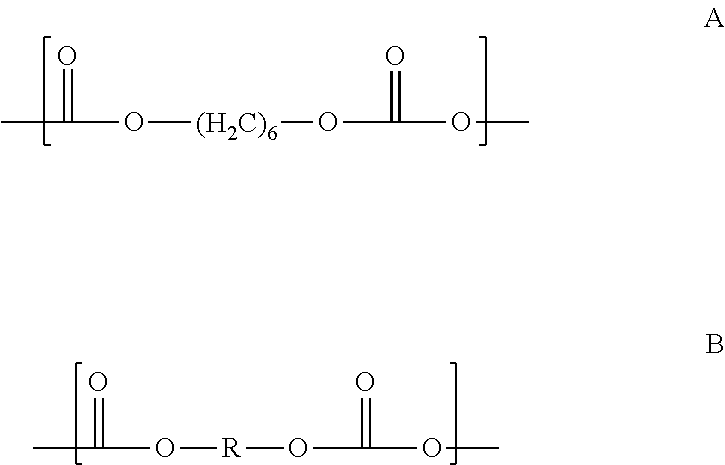Cast urethanes made from low free monomer prepolymer with polycarbonate backbone
- Summary
- Abstract
- Description
- Claims
- Application Information
AI Technical Summary
Benefits of technology
Problems solved by technology
Method used
Image
Examples
examples
[0062]In the following examples “parts” refers to parts by weight, “%” refers to % by weight.
example i
[0063]Prepolymer: To a batch reaction flask equipped with nitrogen sweep, an agitator, a thermometer, a heating mantle, and a vacuum source, was charged 800 parts p-phenylene diisocyanate (PPDI) in 3200 parts of dimethyl adipate (DMA) and then 1904 parts of polycarbonate polyol PC 2000 (MW 1904), creating a mixture with a molar ratio of PPDI to PC diol, (hence the equivalent ratio of NCO groups to OH groups) of 5:1. The mixture was heated for 6 hours at 80° C. with vacuum of 1-10 torr, the crude reaction mixture was then processed through a wiped film evaporator to remove unreacted PPDI and DMA to leave a stripped prepolymer having 3.6% available isocyanate groups and containing less than 0.1% free PPDI, and 0.1% max dimethyl adipate.
[0064]Elastomer: 90 g of the prepolymer was mixed with 7.6 g molten HQEE and the resulting mixture was poured into molds and cured / post cured at 125° C. for 16 hours. Molded articles with excellent toughness were obtained upon demolding after the curing...
example ii
[0065]Prepolymer: Following the prepolymer procedure of Example 1, a mixture of 800 parts p-phenylene diisocyanate (PPDI), 3200 parts of DMA, and 952 parts 1,5 / 1,6 pentane / hexane-Polycarbonate polyol CO—PC 1000 (MW 952) having a molar ratio of PPDI to PC diol, and equivalent ratio of NCO groups to OH groups, of 5:1, was mixed for 6 hours at 80° C. with vacuum of 1-10 torr to provide a crude reaction mixture, which was processed through a wiped film evaporator as above to leave a stripped prepolymer having 5.8% available isocyanate groups and containing less than 0.1% free PPDI, and 0.1% max DMA.
[0066]Elastomer: 90 g of the prepolymer was mixed with 12.4 g molten HQEE and the resulting mixture was poured into molds and cured / post cured at 125° C. for 16 hours. Molded articles with excellent toughness were obtained upon demolding after the curing / post curing cycle.
PUM
| Property | Measurement | Unit |
|---|---|---|
| Temperature | aaaaa | aaaaa |
| Fraction | aaaaa | aaaaa |
| Fraction | aaaaa | aaaaa |
Abstract
Description
Claims
Application Information
 Login to View More
Login to View More - R&D
- Intellectual Property
- Life Sciences
- Materials
- Tech Scout
- Unparalleled Data Quality
- Higher Quality Content
- 60% Fewer Hallucinations
Browse by: Latest US Patents, China's latest patents, Technical Efficacy Thesaurus, Application Domain, Technology Topic, Popular Technical Reports.
© 2025 PatSnap. All rights reserved.Legal|Privacy policy|Modern Slavery Act Transparency Statement|Sitemap|About US| Contact US: help@patsnap.com



